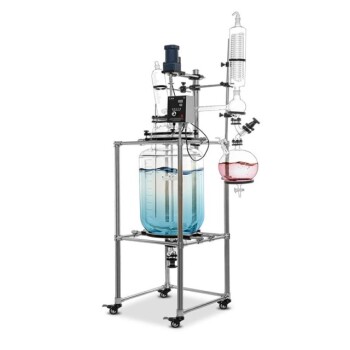The rotation of the flask in a rotary evaporator (rotovap) is a critical design feature that enhances the efficiency and effectiveness of the evaporation process. By rotating the flask, the solvent forms a thin film on the inner surface of the flask, significantly increasing the surface area available for evaporation. This increased surface area, combined with the reduced pressure (vacuum) and controlled heating from the water bath, accelerates the evaporation rate. Additionally, the rotation helps prevent issues like "bumping," ensures uniform temperature distribution, and improves overall process stability. Below is a detailed explanation of the key reasons behind this design choice.
Key Points Explained:

-
Increased Surface Area for Evaporation
- Rotation causes the solvent to spread into a thin film along the inner walls of the flask.
- This thin film provides a much larger surface area compared to a stationary flask, where the solvent would pool at the bottom.
- A larger surface area allows more solvent molecules to escape into the vapor phase simultaneously, significantly speeding up the evaporation process.
-
Prevention of Bumping
- "Bumping" occurs when a large pocket of solvent vapor forms rapidly, displacing the surrounding liquid and potentially causing spills or contamination.
- Rotation ensures a more controlled and gradual evaporation process, reducing the likelihood of sudden vapor formation.
- The centrifugal force from rotation keeps the liquid distributed evenly, minimizing localized overheating and vapor pockets.
-
Enhanced Heat Transfer and Uniform Temperature Distribution
- Rotation ensures that the solvent is constantly agitated and exposed to the heated surface of the flask.
- This agitation promotes uniform heat distribution, preventing hot spots that could lead to uneven evaporation or degradation of heat-sensitive compounds.
- The consistent movement also improves heat transfer from the water bath to the solvent, further enhancing efficiency.
-
Improved Evaporation Efficiency Under Vacuum
- The combination of rotation and reduced pressure (vacuum) lowers the boiling point of the solvent.
- By increasing the surface area and reducing the boiling point, rotation maximizes the effectiveness of the vacuum, allowing solvents to evaporate at lower temperatures.
- This is particularly important for heat-sensitive materials that could degrade at higher temperatures.
-
Centrifugal Force and Thin Film Formation
- The centrifugal force generated by rotation keeps the solvent adhered to the inner walls of the flask, forming a thin, uniform layer.
- This thin film ensures that the solvent is evenly exposed to the heat source and vacuum, optimizing the evaporation process.
- The continuous rotation ensures that fresh solvent is always being brought to the surface for evaporation.
-
Reduction of Spills and Contamination
- By preventing bumping and ensuring a controlled evaporation process, rotation minimizes the risk of spills.
- This is especially important when working with hazardous or expensive materials, where contamination or loss must be avoided.
-
Agitation of the Water Bath
- The rotation of the flask also agitates the water bath, promoting better heat transfer and maintaining a consistent temperature.
- This agitation ensures that the flask is uniformly heated, further enhancing the efficiency of the evaporation process.
In summary, the rotation of the flask in a rotary evaporator is a deliberate design feature that addresses multiple challenges in the evaporation process. By increasing the surface area, preventing bumping, ensuring uniform heat distribution, and enhancing the effectiveness of the vacuum, rotation significantly improves the efficiency, safety, and reliability of solvent removal. This makes the rotary evaporator an indispensable tool in laboratories for processes like solvent recovery, concentration, and purification.
Summary Table:
| Key Benefits of Flask Rotation | Explanation |
|---|---|
| Increased Surface Area | Forms a thin film for faster evaporation. |
| Prevents Bumping | Reduces sudden vapor formation and spills. |
| Uniform Heat Distribution | Ensures even heating and prevents hot spots. |
| Improved Vacuum Efficiency | Lowers boiling points for heat-sensitive materials. |
| Reduced Spills and Contamination | Minimizes risks during evaporation. |
Learn how a rotary evaporator can optimize your lab processes—contact us today for expert advice!


















